by Angela Hinkle | Nov 21, 2014
 Gratitude doesn’t have to happen only on World Gratitude Day or around the Thanksgiving table. Happiness researchers have found that expressing gratitude has wide-ranging benefits. Counting your blessings on a frequent basis is associated with increased happiness. Grateful people are more likely to:
Gratitude doesn’t have to happen only on World Gratitude Day or around the Thanksgiving table. Happiness researchers have found that expressing gratitude has wide-ranging benefits. Counting your blessings on a frequent basis is associated with increased happiness. Grateful people are more likely to:
- take better care of themselves both mentally and physically
- get more regular exercise
- eat a healthier diet
- have improved mental alertness
- schedule regular physical examinations with their doctor
- cope better with stress and everyday challenges
- feel happier and more optimistic
- report more hours and better quality of sleep
- experience fewer physical symptoms like headaches, coughing, nausea, or pain
- have stronger immune systems
- maintain a brighter view of the future
So how do you put more thanks-giving and gratitude into your day? Try these suggestions to give yourself a boost:
- Be mindful of what you have. It’s not how much you have, but how you feel about what you have, that makes the difference.
- Write it down or share with a group that you meet with on a routine basis. This is a great way to continually give thanks.
- If someone thanks you, accept the thanks graciously. Let the person know you appreciate being thanked. You don’t need to do anything else. Honestly.
- Look for small things to be thankful for. The only person they have to be meaningful to is you. Here are some examples: “I found a parking space right away”; “It’s raining and I remembered my umbrella today”; “I was in a hurry and someone let me go in front of them in the line at the store”; “I had a good hair day.”
- If you write a thank you note, keep it short and simple. It’s not a big report that’s due or the novel you keep putting off writing. Just think of the reason for the thank you and be sincere. If you forgot to send a thank you note, don’t let the elapsed time be an excuse to avoid the task all together. You can send a quick email and then get to the real thing.
During the holiday season and throughout the year, enjoy and be thankful for the little and the big things and the kindnesses of others. Gratitude is good for your head, good for your heart, and good for your soul. And, just so you know, we take you very seriously – thanks for taking the time to read this message.
by Judy Corbus | Nov 21, 2014
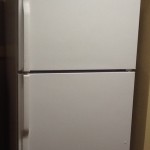 Do you have food containers growing green fuzzies in the back of your refrigerator? It’s easy for leftovers and other food items to overstay their welcome in the fridge, creating a food safety hazard as well as unnecessary clutter. With Thanksgiving and the start of the holiday season just around the corner, now is the perfect time to super-clean your refrigerator. Follow these tips to get your refrigerator ready for Thanksgiving leftovers and other holiday treats:
Do you have food containers growing green fuzzies in the back of your refrigerator? It’s easy for leftovers and other food items to overstay their welcome in the fridge, creating a food safety hazard as well as unnecessary clutter. With Thanksgiving and the start of the holiday season just around the corner, now is the perfect time to super-clean your refrigerator. Follow these tips to get your refrigerator ready for Thanksgiving leftovers and other holiday treats:
- Remove everything from the refrigerator.
- Examine each container – discard outdated leftovers and any items of whose age you are uncertain or you don’t plan to use in the near future.
- Remove shelves, drawers, and bins. Wash with a solution of baking soda and warm (not hot) water.
- Clean the interior of the refrigerator with baking soda and warm water. Dishwashing detergent can leave a residue that can lead to odors if not rinsed thoroughly. Dry with a soft cloth or paper towel.
- Clean each container before returning it to the refrigerator.
- Wash the outside of the refrigerator with sudsy water (using hand dishwashing detergent), rinse, and dry. Wash the gaskets around the refrigerator doors – sticky gaskets can cause air leaks, costing you more energy over time.
- Vacuum the dust off the condenser coils, usually on the back of the refrigerator, or under it. Dirty, dusty coils make the refrigerator work harder to cool and use more energy, costing you more money.
- Remove and clean the “pan” or plastic tray at the very bottom of the refrigerator that collects the condensation or defrost water. Look in your care manual to find where this “pan” is located. Dust and moisture in this “pan” can cause mold to grow, causing health problems for people with allergies.
- Clean the floor around and underneath the refrigerator.
Your fridge is now ready for the holidays!
Sources: My Florida Home Book – Taking Care of Your Home, Chapter 5. Taking Care of Indoor Features, University of Florida/IFAS Extension, 2008.
http://www.cooksinfo.com/clean-out-your-refrigerator-day
by Elizabeth | Aug 6, 2014

Vaccines are responsible for the control of many infectious diseases that were once common in worldwide.
Make sure that your family and friends are up-to-date on their immunizations. With children enrolling in or returning to school, older students entering college, and adults and the health care community preparing for the upcoming flu season, this is a particularly good time to focus community attention on the value of immunization.
Vaccines are responsible for the control of many infectious diseases that once were common worldwide. Vaccines have reduced and, in some cases, eliminated many diseases that once routinely killed or maimed tens of thousands of infants, children and adults.
The viruses and bacteria that cause vaccine-preventable diseases and death still exist and can infect people who are not protected by vaccines. Vaccine-preventable diseases have a costly impact, resulting in doctors’ visits, hospitalizations, and premature deaths. (Sick children also can cause parents to lose time from work.)
Now, suppose you could make your child safe from some of the deadliest diseases in history and suppose that, at the same time, you also could help protect your neighbors’ children and other children around the country from the same diseases. Finally, suppose you could actually help to rid the world of some of these diseases that have been crippling and killing children for centuries.
You can do all of these things with one of the easiest and, yet, most powerful health tools ever developed. You can make sure your children get their shots.
There are 12 potentially serious diseases that vaccines protect against:
- Diphtheria,
- Haemophilus Influenza Type b (Hib)
- Hepatitis A
- Hepatitis B
- Measles
- Mumps
- Pertussis (Whooping Cough)
- Pneumococcal disease
- Polio
- Rubella (German Measles)
- Tetanus (lockjaw)
- Varicella (Chickenpox)
At least one shot is needed for each of these diseases, and for some of them, several doses are required for the best protection.
For more information on immunizations, call your local Health Department or contact your child’s pediatrician. You also may visit the CDC website at http://www.cdc.gov/vaccines/schedules/easy-to-read/child.html.
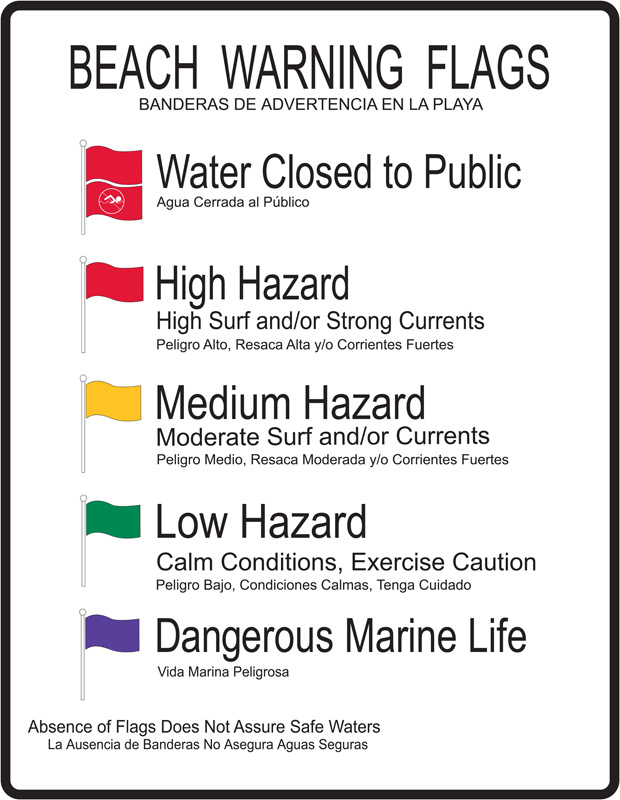
by Ricki McWilliams | Jun 27, 2014
Have a Wonderful Summer in the Water
With the recent official start of Summer water related activities are in full swing. When you and your loved ones are around the water it is important to know the basic safety and survival skills.
Water-safety survival skills:
- floating or treading water for one minute without a flotation device
- stepping or jumping into water over your head and returning to the surface
- treading water or floating in a full circle and then finding a way out of the water
- exiting a pool without using a ladder
- swimming 25 yards (the length of a standard pool) without stopping
Only 56% of adults who say they can swim can perform the 5 critical water-safety skills that could save their lives. (American Red Cross)
It is important to know how to swim and make smart choices around the water:
- always swim in designated areas supervised by lifeguards
- always swim with a buddy
Our emerald waters and white sandy beaches make visiting the Gulf a fun, family weekend activity but it is important to look for the beach flag warning system and know what each flag means.
[important]
Flag Warning System:
- Double Red Flag: Water is closed to public (dangerous water conditions)
- Red Flag: High Hazard (high surf and/or strong currents)
- Yellow Flag: Medium Hazard (moderate surf and/or currents)
- Green Flag: Low Hazard (calm conditions, exercise caution)
- Purple Flag: Marine Pests Present (jellyfish, stingrays, dangerous fish)
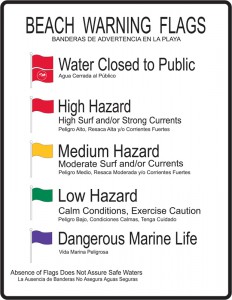
[/important]
Thinking you can do more in the water than you are capable of can endanger you as well as others. A recent CDC report noted that about 21,000 children and young adults drowned from 1999 through 2010. For people aged 29 and younger, drowning is one of the top three causes of unintentional injury or death.
Contact your local UF/IFAS Extension agent, local community pool or the American Red Cross to find more information on swimming lessons, water-safety education programs, and training opportunities for lifeguards and water-safety instructors.
by Judy Corbus | Jun 27, 2014
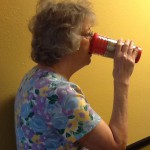 “Whew, I’m thirsty!” As temperatures rise, you may be saying that more frequently and for good reason. Better than one-half of our body weight is water and we lose water daily in sweat, urine, and feces. Water converts food into energy, regulates our body temperature, protects and cushions vital organs, and promotes regular bowel movements. In hot weather and during physical activity, it is easy to become dehydrated if we lose more water than we consume. Symptoms of dehydration include: difficulty swallowing, dry mouth due to low saliva production, headaches, fatigue, loss of appetite, dry eyes, muscle cramps, and kidney stones.
“Whew, I’m thirsty!” As temperatures rise, you may be saying that more frequently and for good reason. Better than one-half of our body weight is water and we lose water daily in sweat, urine, and feces. Water converts food into energy, regulates our body temperature, protects and cushions vital organs, and promotes regular bowel movements. In hot weather and during physical activity, it is easy to become dehydrated if we lose more water than we consume. Symptoms of dehydration include: difficulty swallowing, dry mouth due to low saliva production, headaches, fatigue, loss of appetite, dry eyes, muscle cramps, and kidney stones.
Most persons need six to eight cups of fluid every day. If you are eating high-fiber foods or taking a fiber supplement, taking certain medications, especially diuretics or “water pills,” engaging in vigorous physical activity, or the weather is hot and humid, you will need to increase your fluid intake. One-third of healthy persons 65 years or older have mild dehydration. If you have a senior adult in your life, encourage them to drink plenty of fluids to stay hydrated.
In addition to water, include these beverages regularly:
- Fruit juices – 100 percent juice, not a juice drink, which has added sugar. Six fluid ounces a day is enough.
- Low-sodium vegetable juices
- Low-fat or fat-free milk
- Vegetable or milk-based soups
Here are a few tips for adding more fluids:
- Start the day with a cup of water.
- Drink a cup of water about ½ hour before meals.
- Drink a full glass of water with your medications. This is best for most medications, but check with your pharmacist.
- Drink water before heading outdoors for yardwork or recreation. Thirst indicates fluid loss so drink before you feel thirsty. Take frequent water breaks during outdoor activity, especially in heat and high humidity. Drink one to two cups, or more if needed, of water during and after being outdoors.
- Fill a water bottle and carry it with your during the day.
- Eat “juicy” fruits, such as watermelon, peaches, cantaloupe, and honeydew. Chill for a refreshing treat.
What about sports drinks? Sports drinks contain water, sugar for energy, and electrolytes, including sodium, to replace those lost through perspiration. They promote fluid retention and tend to encourage fluid intake because of their taste. They are highly recommended during intense physical activities that last over one hour. For casual activities of less than an hour, water is a good choice for hydration. Be aware that beverages high in sugar, including fruit juices, can cause nausea or gastrointestinal distress. Caffeine or alcohol increase urine output and reduce fluid retention. Carbonated beverages can make you feel full, decreasing the amount of fluid you drink.
So stay hydrated this summer with healthy fluid choices to beat the heat!
Sources: Healthy Eating: Fluids
Casa, D.J., et al. Fluid Replacement for Athletes Journal of Athletic Training. 2000; 35(2): 212224.
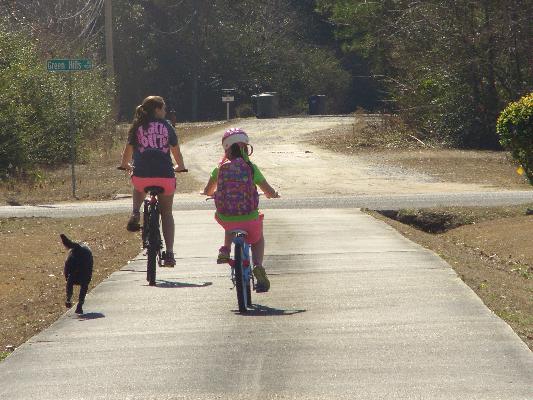
by Angela Hinkle | Jun 27, 2014
“School’s out!” Time to head outdoors to play.
In their Physical Activity Guidelines, the Department of Health and Human Services, http://www.health.gov, recommends at least one hour of moderate to vigorous physical activity every day for overall better health. No worries, though. You don’t have to do it all at once and what you and your family choose to do should be fun and keep your interest.
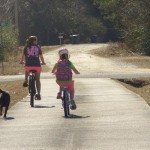 Here are a few reminders when staying physical:
Here are a few reminders when staying physical:
- Water, water, and more water – make sure you replenish your fluids. Try drinking your water with ice, fruit, bendable straws, or from bottles with funky-colored sleeves to keep it interesting. Keep plenty of fruits and veggies on hand for snacks to stay hydrated as well.
- Apply, apply, and apply – sunscreen, that is. Set up a sunscreen station so everyone knows where to find the various bottles, sticks, and sprays of sunscreen. Small bottles of sunscreen with hooks that hang on belt loops are also becoming more readily available.
- Pick the best time of day for you. For many, earlier in the day or later in the afternoon are a little cooler, which makes it easier to be outside. (Unfortunately, those are mosquitoes’ favorite times of the day, too, so be sure to use protection against mosquito and other bug bites.)
- Pick the right environment. Make sure you have some shady spots or have the ability to come indoors to cool off.
- More water – water balloons, water squirters, and sprinklers are always fun. Poke holes in an empty plastic 2- liter soda bottle, attach a hose to the bottle opening, and hang it upside down to make a great outdoor shower.
So what are you waiting for? Go out and (safely) have some fun in the sun!
 Gratitude doesn’t have to happen only on World Gratitude Day or around the Thanksgiving table. Happiness researchers have found that expressing gratitude has wide-ranging benefits. Counting your blessings on a frequent basis is associated with increased happiness. Grateful people are more likely to:
Gratitude doesn’t have to happen only on World Gratitude Day or around the Thanksgiving table. Happiness researchers have found that expressing gratitude has wide-ranging benefits. Counting your blessings on a frequent basis is associated with increased happiness. Grateful people are more likely to:






